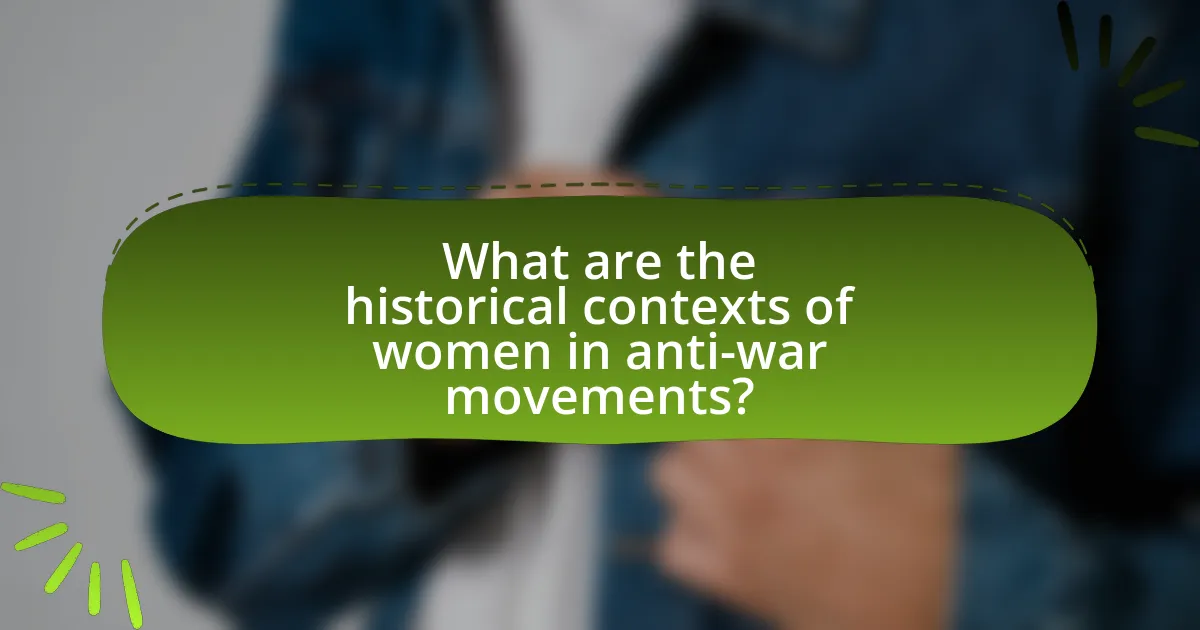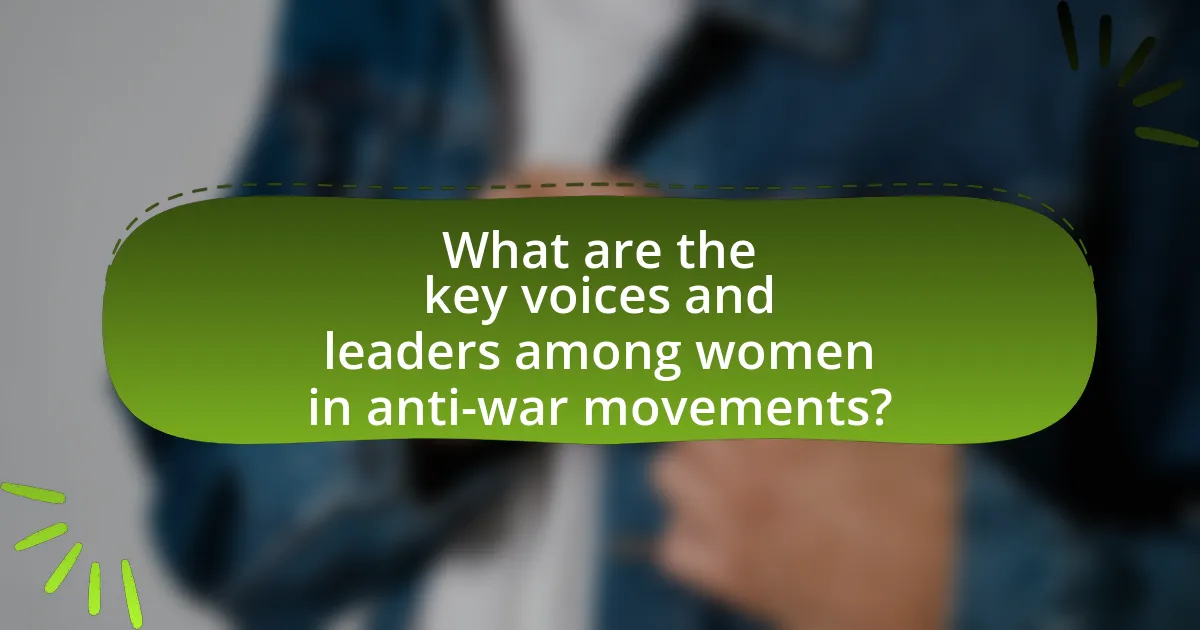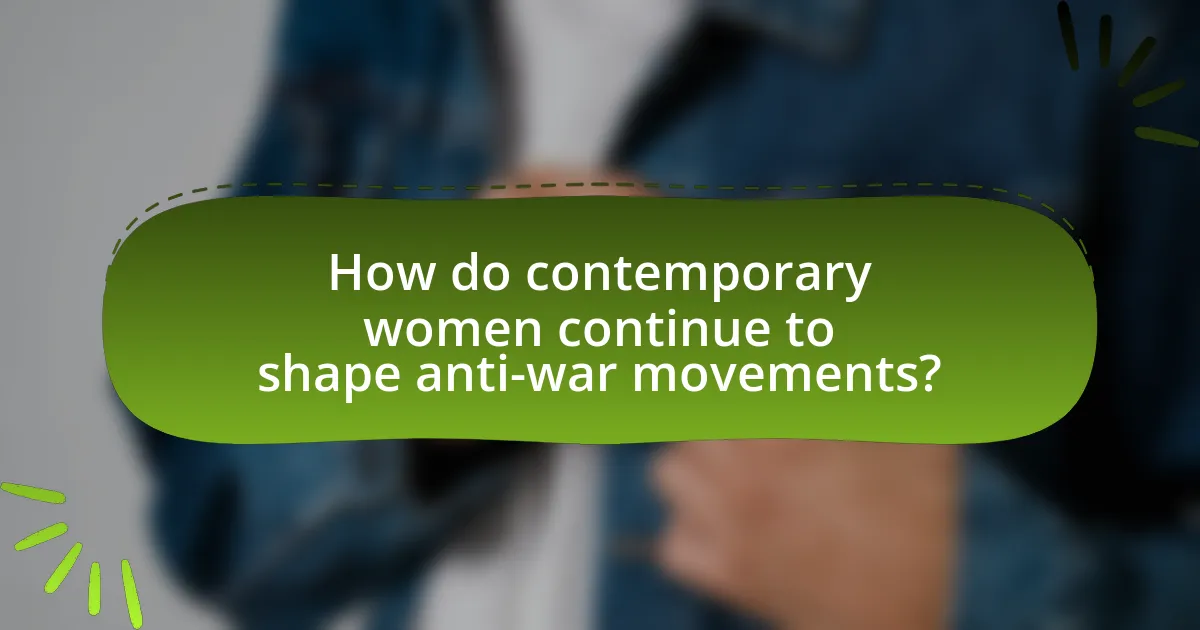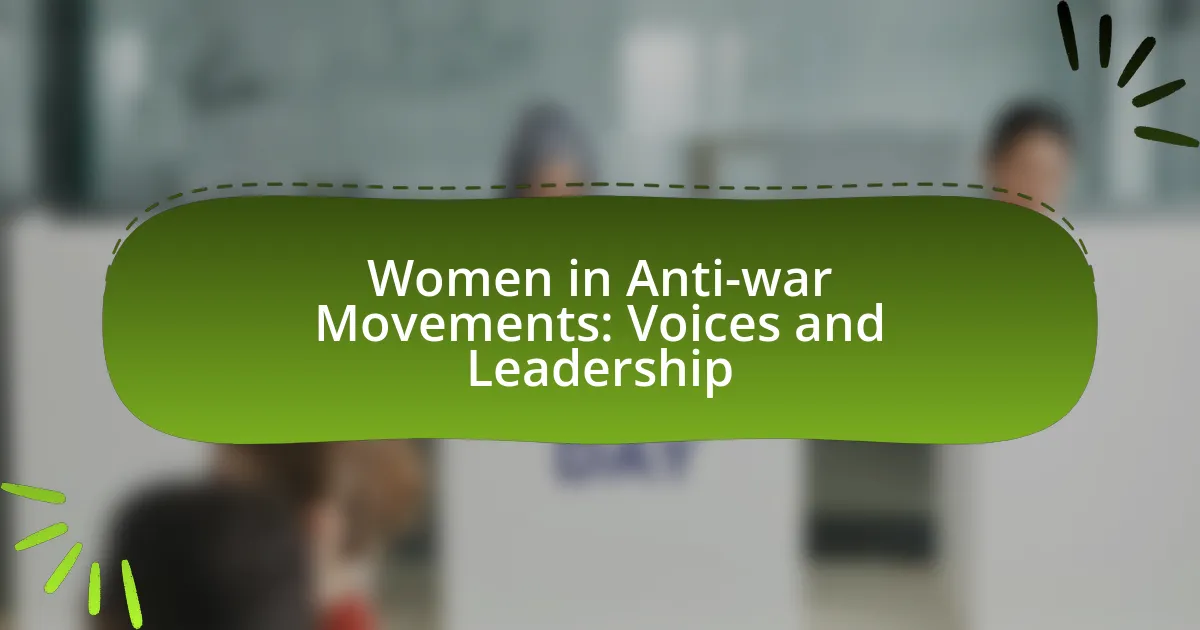The article focuses on the significant roles women have played in anti-war movements throughout history, highlighting their contributions, challenges, and leadership. It examines historical contexts, such as the Women’s Peace Party and the activism during the Vietnam War, showcasing key figures like Jane Addams and Medea Benjamin. The discussion includes the impact of societal attitudes on women’s participation, the obstacles they face in gaining recognition, and the importance of grassroots organizations in empowering women. Additionally, it addresses contemporary issues women are tackling in modern anti-war activism, emphasizing the influence of intersectionality and the use of social media platforms for advocacy.

What are the historical contexts of women in anti-war movements?
Women have played significant roles in anti-war movements throughout history, often emerging as key voices advocating for peace and social justice. During the 19th century, women like the abolitionist and suffragist Lucretia Mott participated in the peace movement, opposing the Mexican-American War and advocating for disarmament. In the early 20th century, women organized against World War I, forming groups such as the Women’s Peace Party in 1915, which highlighted the impact of war on families and communities. The Vietnam War era saw a surge in women’s activism, with figures like Jane Fonda and the Women’s International League for Peace and Freedom mobilizing protests and raising awareness about the war’s consequences. These historical contexts illustrate how women have consistently challenged militarism and sought to influence public policy through grassroots organizing and advocacy.
How have women contributed to anti-war movements throughout history?
Women have significantly contributed to anti-war movements throughout history by organizing protests, advocating for peace, and influencing public opinion. For instance, during World War I, women formed groups like the Women’s Peace Party in the United States, which was instrumental in promoting pacifism and opposing the war. Additionally, women played a crucial role in the 1960s anti-Vietnam War movement, with figures such as Betty Friedan and the Women’s Strike for Peace mobilizing thousands to demand an end to military involvement. Their efforts not only highlighted the human cost of war but also brought attention to issues such as civil rights and social justice, demonstrating the interconnectedness of these movements. Historical records show that women’s participation in these movements often led to significant policy changes and increased awareness of the consequences of war.
What significant events marked women’s involvement in anti-war activism?
Significant events that marked women’s involvement in anti-war activism include the Women’s Peace Party founded in 1915, which was a response to World War I, and the Women’s International League for Peace and Freedom established the same year. These organizations mobilized women to advocate for peace and disarmament. Additionally, during the Vietnam War, the 1965 anti-war march organized by women, including the notable “Women Strike for Peace,” highlighted women’s leadership in opposing military conflict. The 1970s saw the formation of groups like the “Women’s Anti-War Coalition,” which further solidified women’s roles in anti-war efforts. These events collectively demonstrate women’s critical contributions to anti-war movements throughout history.
How did societal attitudes towards women influence their roles in these movements?
Societal attitudes towards women significantly influenced their roles in anti-war movements by both limiting and empowering their participation. Historically, prevailing gender norms often relegated women to supportive roles, which initially constrained their visibility and leadership in these movements. However, as societal perceptions began to shift, particularly during the 1960s and 1970s, women increasingly asserted their voices, challenging traditional gender roles and advocating for peace. For instance, organizations like Women Strike for Peace emerged, demonstrating women’s capacity to mobilize and lead protests against war, thereby reshaping public perceptions of women’s roles in activism. This evolution illustrates how changing societal attitudes not only allowed women to participate more actively but also positioned them as crucial leaders in the anti-war discourse.
What challenges have women faced in anti-war movements?
Women in anti-war movements have faced significant challenges, including marginalization within the movements, gender-based discrimination, and societal stereotypes. Marginalization often occurs as women’s contributions are overlooked or minimized compared to their male counterparts, leading to a lack of representation in leadership roles. Gender-based discrimination manifests in the form of dismissive attitudes towards women’s perspectives and experiences, which are frequently deemed less credible or relevant. Societal stereotypes further complicate women’s involvement, as traditional gender roles can discourage active participation in political activism. Historical examples, such as the Women’s Peace Party founded in 1915, illustrate these challenges, where women fought for recognition and influence in a predominantly male-dominated sphere.
How have gender biases affected women’s leadership in these movements?
Gender biases have significantly hindered women’s leadership in anti-war movements by perpetuating stereotypes that undermine their authority and contributions. For instance, women often face skepticism regarding their capabilities to lead, as traditional gender roles associate leadership with masculinity. This bias is evident in historical contexts, such as the Vietnam War protests, where women’s voices were marginalized despite their active participation. Research indicates that women in these movements frequently encounter challenges in gaining recognition and support, which limits their influence and decision-making power. Studies show that when women do lead, they often adopt collaborative approaches that differ from conventional leadership styles, yet these methods are frequently undervalued in a male-dominated environment.
What obstacles have women encountered in gaining recognition for their contributions?
Women have encountered significant obstacles in gaining recognition for their contributions in anti-war movements, primarily due to systemic gender biases and societal norms that undervalue women’s roles. Historical accounts reveal that women’s activism has often been marginalized, with their contributions overshadowed by male counterparts, as seen in movements like the Women’s Peace Party founded in 1915, which struggled for visibility against male-dominated organizations. Additionally, research indicates that women frequently face challenges such as lack of access to leadership positions and media representation, which further diminishes their visibility and acknowledgment in these movements. For instance, a study by the Institute for Women’s Policy Research highlights that women are often relegated to supportive roles rather than being recognized as leaders, impacting their ability to gain credit for their efforts.

What are the key voices and leaders among women in anti-war movements?
Key voices and leaders among women in anti-war movements include figures such as Jane Addams, who co-founded the Women’s International League for Peace and Freedom in 1915, advocating for peace and disarmament. Another prominent leader is Medea Benjamin, co-founder of Code Pink, an organization that protests against U.S. military interventions and advocates for peace. Additionally, women like Angela Davis have played significant roles in linking anti-war activism with broader social justice issues. These leaders have mobilized grassroots movements, organized protests, and influenced public policy through their advocacy, demonstrating the critical impact of women’s leadership in anti-war efforts.
Who are some prominent women leaders in anti-war history?
Prominent women leaders in anti-war history include Jane Addams, who co-founded the Women’s International League for Peace and Freedom and advocated for peace during World War I. Another significant figure is Barbara Lee, the only member of Congress to vote against the Authorization for Use of Military Force in 2001, emphasizing the need for diplomacy over military action. Additionally, Aung San Suu Kyi has been recognized for her efforts in promoting peace and democracy in Myanmar, despite her controversial later years. These women have made substantial contributions to anti-war movements, advocating for peace and social justice throughout their careers.
What impact did these leaders have on the movements they were part of?
These leaders significantly shaped the anti-war movements by mobilizing grassroots support, influencing public opinion, and advocating for policy changes. For instance, women like Jane Addams and Dorothy Day utilized their platforms to highlight the moral implications of war, thereby attracting a diverse coalition of supporters. Their efforts led to increased visibility for anti-war sentiments, as evidenced by the establishment of organizations such as the Women’s Peace Party in 1915, which played a crucial role in promoting peace initiatives. Additionally, their leadership fostered a sense of solidarity among women, empowering them to take active roles in political discourse and activism, ultimately contributing to the broader peace movement and influencing legislative actions against war.
How did their backgrounds shape their perspectives on war and peace?
Women in anti-war movements often have backgrounds that significantly influence their perspectives on war and peace. Many women involved in these movements come from experiences of loss, trauma, or displacement due to conflict, which fosters a deep understanding of the human cost of war. For instance, women who have lived through wars or have family members affected by military actions tend to advocate for peace more passionately, as seen in the testimonies of activists like Medea Benjamin, who co-founded Code Pink and draws from her experiences witnessing the impacts of U.S. military interventions. Additionally, women’s roles in caregiving and community building often lead them to prioritize diplomacy and conflict resolution over militarization, as evidenced by the work of organizations like Women’s International League for Peace and Freedom, which emphasizes non-violent solutions. These backgrounds create a unique lens through which women view the implications of war, often leading them to champion peace initiatives and social justice.
What roles do grassroots organizations play in women’s anti-war activism?
Grassroots organizations play a crucial role in women’s anti-war activism by mobilizing communities, amplifying women’s voices, and fostering solidarity among diverse groups. These organizations often serve as platforms for women to express their opposition to war, organize protests, and advocate for peace policies. For instance, groups like Code Pink and the Women’s International League for Peace and Freedom have historically engaged women in activism through grassroots campaigns, educational initiatives, and direct action, demonstrating the effectiveness of collective action in influencing public opinion and policy. Their efforts have been instrumental in shaping the discourse around war and peace, highlighting the unique perspectives and experiences of women affected by conflict.
How do these organizations empower women to take leadership roles?
Organizations empower women to take leadership roles by providing training, mentorship, and platforms for advocacy. For instance, many anti-war movements actively create programs that focus on skill development in public speaking, negotiation, and strategic planning, which are essential for effective leadership. Additionally, these organizations often highlight women’s contributions and successes within the movement, fostering a culture of recognition and support. Research indicates that women involved in such movements report increased confidence and a greater sense of agency, which are critical factors in stepping into leadership positions.
What strategies do they use to mobilize support for anti-war efforts?
Women in anti-war movements mobilize support through grassroots organizing, coalition-building, and leveraging social media platforms. Grassroots organizing involves community engagement, where women lead local initiatives to raise awareness about the impacts of war, often utilizing personal narratives to connect with diverse audiences. Coalition-building allows them to unite various groups, including veterans, peace organizations, and civil rights activists, amplifying their collective voice and resources. Social media platforms serve as powerful tools for outreach, enabling women to share information, mobilize protests, and create viral campaigns that resonate with a broader audience. For instance, the Women’s March in 2017 effectively utilized social media to mobilize millions globally, showcasing the impact of these strategies in anti-war efforts.

How do contemporary women continue to shape anti-war movements?
Contemporary women shape anti-war movements through leadership roles, grassroots organizing, and advocacy for peace and justice. Women such as CodePink co-founder Medea Benjamin and activist Malala Yousafzai exemplify this influence by mobilizing communities, raising awareness about the consequences of war, and promoting nonviolent solutions. Research indicates that women’s participation in peace movements leads to more sustainable peace agreements, as highlighted in the UN’s 2015 report on Women, Peace, and Security, which emphasizes that women’s involvement is crucial for effective conflict resolution.
What current issues are women addressing in modern anti-war activism?
Women in modern anti-war activism are currently addressing issues such as the impact of militarization on communities, the intersection of gender and war, and the need for inclusive peace processes. These activists highlight how militarization exacerbates social inequalities and disproportionately affects women and marginalized groups. For instance, studies show that women often bear the brunt of conflict-related violence and displacement, which underscores the necessity for their voices in peace negotiations. Additionally, women are advocating for policies that prioritize diplomacy and conflict resolution over military intervention, emphasizing the importance of addressing root causes of conflict rather than relying on military solutions.
How do intersectionality and diversity influence contemporary anti-war movements?
Intersectionality and diversity significantly influence contemporary anti-war movements by broadening the scope of activism to include various social identities and experiences. This approach recognizes that individuals experience oppression differently based on factors such as race, gender, class, and sexuality, which leads to a more inclusive and representative movement. For instance, the Women’s March in 2017 highlighted the intersectional experiences of women of color, LGBTQ+ individuals, and other marginalized groups, emphasizing that anti-war efforts must address not only militarism but also systemic inequalities. Research by the Institute for Women’s Policy Research shows that diverse coalitions are more effective in mobilizing support and fostering solidarity, ultimately leading to more impactful advocacy against war and militarization.
What new platforms are women using to advocate against war today?
Women are increasingly using social media platforms such as Twitter, Instagram, and TikTok to advocate against war today. These platforms allow women to share their messages widely, mobilize support, and engage with global audiences in real-time. For instance, campaigns like #WomenAgainstWar on Twitter have gained traction, enabling women to voice their opposition to military conflicts and promote peace initiatives. Additionally, Instagram serves as a visual medium where women can post impactful images and stories that highlight the human cost of war, further amplifying their advocacy efforts.
What lessons can be learned from women’s leadership in anti-war movements?
Women’s leadership in anti-war movements demonstrates the effectiveness of grassroots organizing and coalition-building. Historical examples, such as the Women’s Peace Party founded in 1915 and the Women’s March on Washington in 2017, illustrate how women mobilize diverse groups to advocate for peace. These movements often emphasize non-violent resistance and community engagement, showcasing that inclusive leadership can amplify voices and foster solidarity. Research indicates that women’s participation in peace processes leads to more sustainable agreements, as seen in the United Nations Security Council Resolution 1325, which recognizes the critical role of women in conflict resolution. Thus, the lessons learned highlight the importance of collaboration, inclusivity, and the unique perspectives women bring to peace advocacy.
How can these lessons inform future activism and leadership strategies?
Lessons from women in anti-war movements can inform future activism and leadership strategies by emphasizing the importance of inclusive participation and grassroots organizing. Historical examples, such as the Women’s Peace Party founded in 1915, demonstrate that diverse voices enhance the effectiveness of movements, leading to broader public support and engagement. Additionally, the strategic use of nonviolent protest, as seen in the actions of women during the Vietnam War era, illustrates that peaceful methods can achieve significant political impact. These lessons highlight that future activism should prioritize collaboration, community-building, and nonviolent tactics to foster sustainable change.
What best practices can be adopted from successful women-led initiatives?
Successful women-led initiatives often adopt best practices such as inclusive decision-making, community engagement, and leveraging networks for support. Inclusive decision-making ensures diverse perspectives are considered, which enhances the effectiveness of strategies. For instance, the Women’s March in 2017 exemplified this by involving various groups and voices, leading to a broad coalition that amplified their message. Community engagement fosters trust and mobilizes grassroots support, as seen in initiatives like Women for Women International, which empowers women in conflict zones through local partnerships. Leveraging networks for support, such as the Global Fund for Women, allows women-led initiatives to access resources and amplify their impact, demonstrating the importance of collaboration in achieving common goals.
How can individuals support women in anti-war movements today?
Individuals can support women in anti-war movements today by actively participating in advocacy efforts, donating to organizations led by women that focus on peace and conflict resolution, and amplifying their voices through social media platforms. Engaging in local and national campaigns that promote women’s leadership in peace initiatives is crucial, as studies show that women’s involvement in peace processes significantly increases the likelihood of sustainable peace (UN Women, 2015). Additionally, attending events, workshops, and discussions that highlight women’s contributions to anti-war efforts fosters community support and awareness.



